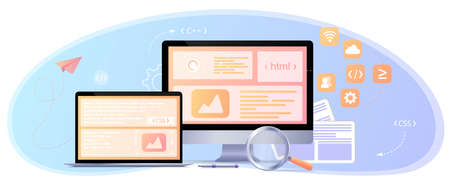Introduction to Canonical URLs
If you’ve ever managed a website or dabbled in SEO, you may have come across the term “canonical URL.” But what exactly does it mean? In the simplest terms, a canonical URL is the preferred web address for a specific piece of content. When search engines like Google crawl your website, they often find multiple pages with similar or even identical content. This can happen for many reasons—maybe your e-commerce site lists the same product under different categories, or perhaps users can access your homepage using both https://www.example.com and https://example.com. Without clear guidance, search engines might get confused about which version to rank or show in search results. By setting a canonical URL, you’re telling search engines, “This is the main version of this content.” For example, a popular American retailer like Best Buy might have product pages that appear under several URLs due to filters or sorting options. Using a canonical tag ensures only one authoritative version is indexed. This not only streamlines your site’s SEO but also improves your chances of ranking higher on Google and other U.S.-based search engines.
2. How Duplicate Content Can Hurt Your SEO
Duplicate content is one of the most common issues that can negatively impact your website’s search engine optimization (SEO) efforts. When multiple pages on your site contain the same or very similar content, search engines like Google may struggle to determine which version should be ranked in search results. This confusion can lead to diluted ranking signals and reduce the overall visibility of your website.
Why Search Engines Get Confused
Search engines use complex algorithms to crawl, index, and rank web pages. When they encounter duplicate content, they have difficulty figuring out which page is the “main” or most authoritative source. Without a clear signal—like a canonical tag—search engines might:
- Index the wrong page as the primary version
- Split ranking power between duplicates
- Omit important pages from their index altogether
Common Causes of Duplicate Content
| Cause | Example |
|---|---|
| URL Parameters | example.com/page?ref=twitter vs. example.com/page?ref=facebook |
| WWW vs Non-WWW | www.example.com vs example.com |
| HTTP vs HTTPS | http://example.com vs https://example.com |
The Impact on Search Rankings
If you don’t address duplicate content issues, your site’s authority and ranking potential can become fragmented. For instance, backlinks pointing to different versions of the same page won’t combine their value, making it harder for any single page to rank well. In some cases, Google may even flag your site for having low-quality or “thin” content, further hurting your visibility.
This is where canonical URLs become vital—they help you specify which page should be considered the original, consolidating ranking signals and ensuring your most important content gets the attention it deserves from both users and search engines.

3. The Role of the rel=”canonical” Tag
The rel=”canonical” tag is a fundamental tool for managing duplicate content and consolidating ranking signals on your website. In simple terms, this HTML tag tells search engines which version of a page you consider to be the “main” or canonical version. When used correctly, it helps ensure that all the SEO value from similar or duplicate pages is credited to your preferred URL.
To use the rel=”canonical” tag, you need to add a <link rel="canonical" href="https://www.example.com/preferred-page/" /> element within the <head> section of your HTML. This signals to Google and other search engines that if they find multiple versions of this content, they should treat the specified URL as the authoritative source.
This matters for site owners because failing to set a canonical URL can dilute your link equity—meaning, backlinks and SEO signals get split between several URLs instead of building up the authority of one main page. For users, canonical tags help ensure they’re served the most relevant and up-to-date version of your content in search results, improving their overall experience. Whether you run an e-commerce store with product variations or a blog with similar articles, using canonical tags helps keep your site’s SEO clean and effective.
4. Common Mistakes with Canonical URLs
Even though canonical URLs are critical for SEO, many U.S.-based webmasters make common mistakes when implementing them. Understanding these pitfalls can help you avoid duplicate content issues and improve your site’s search engine performance.
Typical Errors in Canonicalization
The following table highlights some of the most frequent canonical URL mistakes and how to steer clear of them:
| Mistake | Description | How to Avoid |
|---|---|---|
| Incorrect Use of Relative URLs | Using relative paths instead of absolute URLs in the rel=”canonical” tag. | Always use absolute, fully qualified URLs (including https://). |
| Pointing All Pages to Homepage | Setting the homepage as canonical for all pages, which confuses search engines. | Ensure each page has its own relevant canonical URL. |
| Multiple Canonical Tags | Including more than one canonical tag on a single page. | Limit each page to a single, clear canonical tag. |
| Canonicalizing Paginated Content Incorrectly | Treating paginated series as duplicates by setting the canonical to the first page in the series. | Use self-referencing canonicals for each paginated page and consider using rel=”next” and rel=”prev”. |
| Mismatched Canonical and Content | The canonical tag points to a different page with unrelated content. | The canonical should always reference a page with substantially similar or identical content. |
Why These Mistakes Matter
Poor implementation can cause Google to ignore your canonicals altogether, resulting in duplicate content issues, diluted ranking signals, and missed SEO opportunities. Inaccurate canonical tags might lead search engines to index the wrong version of your content, impacting both organic traffic and user experience.
Best Practices for U.S. Webmasters
- Regularly audit your website for canonical errors using tools like Google Search Console or Screaming Frog.
- Educate your development team on the correct use of canonical tags, especially during site migrations or redesigns.
- Avoid “set it and forget it”—review canonicals whenever you update or add significant new content.
Pro Tip
If you’re unsure about your current setup, use Google’s URL Inspection Tool to see how Googlebot interprets your canonicals. This proactive step can help catch mistakes before they affect rankings.
5. Best Practices for Implementing Canonical URLs
Getting canonical URLs right is crucial for maximizing your site’s SEO, especially on popular U.S. platforms like WordPress and Shopify. Here are actionable best practices tailored to ensure you’re set up for success:
Use Platform-Specific Tools and Plugins
If you’re using WordPress, take advantage of trusted SEO plugins like Yoast SEO or All in One SEO Pack. These plugins make it easy to set canonical URLs for every page or post without needing to touch code. Shopify users can rest a bit easier—Shopify automatically includes canonical tags for product and collection pages, but always double-check custom templates or apps for compliance.
Always Specify a Canonical URL
Even if you think duplicate content isn’t an issue, explicitly setting a canonical URL helps search engines understand your content hierarchy. This is especially important when similar pages exist (e.g., filtered category views, product variations, or printable versions).
Be Consistent with URL Formatting
Keep your URLs consistent—use either “www” or non-“www”, stick to either HTTP or HTTPS (preferably HTTPS), and avoid trailing slash discrepancies. Inconsistent URLs can confuse search engines and dilute your ranking signals.
Avoid Multiple Canonical Tags
Each page should only have one canonical tag. Having multiple tags can send mixed signals to Google and hurt your rankings. Double-check your theme files, plugins, and custom code to prevent accidental duplication.
Use Absolute URLs
When specifying the canonical URL, use the full absolute path (e.g., https://yourwebsite.com/page/) rather than a relative path (/page/). Absolute URLs are less prone to misinterpretation by search engines and are widely recommended by Google.
Test and Monitor Regularly
After implementation, run regular checks using tools like Google Search Console’s URL Inspection Tool or third-party crawlers such as Screaming Frog. This ensures that your canonical tags are correctly recognized and there are no conflicts or errors that could impact your SEO.
6. Conclusion: Why Canonicalization is Critical for Your Business
Canonical URLs are more than just a technical SEO tactic—theyre essential for U.S. businesses looking to maximize their online visibility, maintain brand credibility, and provide a seamless user experience. By properly implementing canonical tags, you ensure that search engines like Google understand which version of your content is the primary one, helping to prevent duplicate content issues that can dilute your rankings. This is especially important in competitive markets where every ranking position counts. For American businesses, canonicalization also supports consistent messaging across multiple channels and devices, which can boost trust and engagement among your audience. Ultimately, taking control of your canonical URLs not only streamlines your site’s architecture but also strengthens your SEO foundation, helping you stand out in the crowded digital landscape and drive sustainable business growth.


